#Four Approaches of Formal Analysis
Explore tagged Tumblr posts
Text
Four Approaches of Formal Analysis and a painting of Salvador Dali
When criticising an artwork there are four approaches of formal analysis and they are description focuses on what you see by describing the art elements and principles of design that an artwork has, analysis focus on how the art elements and principles of design work together in this artwork, interpretation focuses on what is the meaning or mood of the artwork and judgment focuses on the evaluation of success of the artwork.
I am going to talk more by criticising an artwork using the four approaches I have just mentioned of formal analysis the artwork that I chose is called Swans Reflecting Elephants made by Salvador Dali. This painting was made in 1937 it a Surrealism style created on canvas and painted with oil paint. In this artwork you can see different coloured values that are blend of browns, blues, white and black, shades of darker colour, tint of lighter colour and a bit of highlights in the middle of the artwork. Is also has forms of biometric that is made nature and irregular, form to create a shade of illusion with light in the howl painting. The lines that this painting has are diagonal, curved and line quality of thickness even thinness on the trees, horizontal line is on the back of the trees. On the trees you can also see a bit of shape that has organic effect and the positive and negative space. On the rocks it has a bit of texture and a smooth texture on the animals, pond, trees and the clouds. It also has space of overlapping, sizes are different, lose detail, placement of closer to the horizon line appear farther away and the colour as lose brightness when is farther away. The balances that this painting has are colour, value and texture. This painting is also has the golden ratio and a rhythm of flowing that shows an organic feeling. The artwork has a unity of similarity also variety of different versions of art elements. My analysis about this painting it has a lot of art elements and a bit of design principles but it has a great balance of colours, values and textures so with these effects it made the artwork to have a rhythm, unity, proportion and variety that made the painting more interesting, effective and eye catching. The interpretation of the painting that shows the swans and elephants they have a symbolic meaning like the swans symbolize self-love, loyalty, grace, trust, love, beauty, purity and light. Elephant symbolize wisdom, vitality good luck, memory, power, prosperity, long life and strength. That is why Salvador Dali wants to show that he loves art and his passing the wisdom. My judgment of this painting is that when looking at the painting in a distance the swans and the elephants are hard to notice because it has too much detail on the background so my eyes mostly were focusing on the background not on the swans and elephants that has a symbolic meaning, so at first I thought it was a landscape only with no animals. In my own opinion I think that this painting could have been better if the artist had used lighter colours so the swans and the reflection of the elephant are viewed more with brighter colours so the people’s eyes will focus on the swans and the elephants.

Figure 1: Swans Reflecting Elephants, Salvador Dali, 1937
References list:
ALEX+ANI, 2022. History + Meaning of the Elephant.[online].Available at: <https://www.alexandani.com/blogs/the-wire/symbol-meaning-elephant#:~:text=Why%20Elephants%20Are%20A%20Popular,long%20life%2C%20memory%20and%20vitality> [Accessed 28 October 2021].
Garth Cilfford, C. 2021. Swan Symbolism & Meaning (+Totem, Spirit & Omens).[online].Available at: <https://worldbirds.com/swan-symbolism/> [Accessed 28 October 2021].
Gutierrez, E. 2022. Salvador Dali’s Swans Reflecting Elephants / Analysis.[online].Available at: <https://enriqueg112.medium.com/salvador-dalis-swans-reflecting-elephants-analysis-1f6e4493e94d#:~:text=Swans%20are%20a%20symbol%20of,and%20the%20wisdom%20Dali%20possessed.> [Accessed 28 October 2021].
#art criticism#task 3#Four Approaches of Formal Analysis#Salvador Dali#painting#Swans Reflecting Elephants#1937
0 notes
Text
Character Analysis: Byakuya Kuchiki
Captain Byakuya Kuchiki is a fan favorite, but his bad attitude typically gets him into a lot of trouble. Over time, we learned much more about Byakuya Kuchiki and what makes him such a great character after all. Byakuya redeemed himself and became a supportive brother and her after all, making him a real standout in Bleach. But in different parts of the story, Byakuya Kuchiki also showed his worst side, such as his negative personality traits or making ill-advised decisions.
His Background and Finding Love


Byakuya comes from the prestigious Kuchiki clan, one of the four noble families in the Soul Society. As the head of the Kuchiki family, he inherited the position of captain of the 6th Division. Byakuya's early life was marked by his dedication to the principles of the Kuchiki clan, emphasizing discipline and adherence to rules.
Byakuya's controversial decision to marry a commoner seemed like a bad idea, since he could potentially tarnish the noble Kuchiki family's name with this marriage. Even though the marriage was against Soul Society law, Byakuya went through with it anyway out of true happiness. The shrine with Hisana's picture serves as a heartbreaking reminder of Byakuya's enduring love and the profound impact she had on his life.
Adoption and His Treatment of Rukia

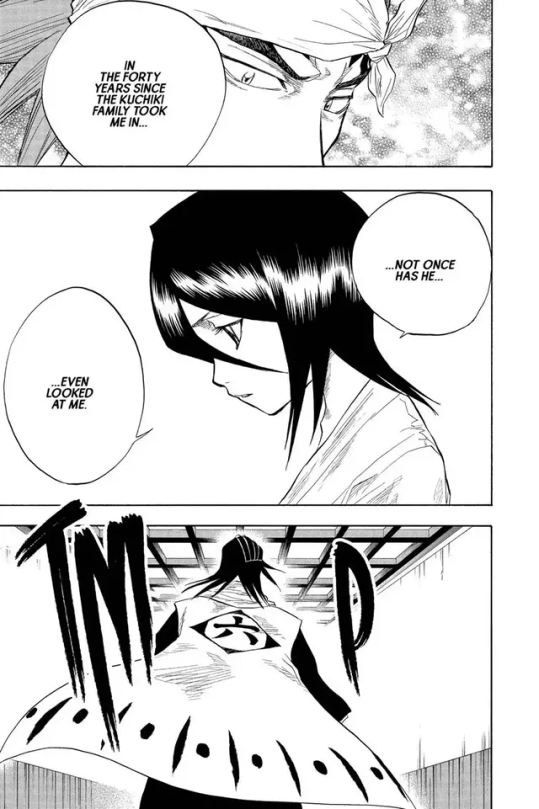
Byakuya adopted a young Rukia after the death of Hisana, fulfilling a promise he made to his dying wife. Byakuya's adherence to duty and tradition led him to adopt his sister-in-law , but the guilt of bending the rules strained their relationship.
The formal ceremony symbolized a turning point, integrating Rukia into the prestigious Kuchiki family. Byakuya's cold demeanor towards her stemmed from his duty as captain and the strict traditions of the Kuchiki clan. In an attempt to reconcile his actions with the expectations of the Kuchiki clan, Byakuya adopted a distant and cold demeanor towards Rukia. This behavior served as a coping mechanism to suppress his internal conflict, allowing him to maintain a façade of adherence to the clan's principles. His stoicism can also be seen as a form of self-punishment, as he grappled with the guilt of breaking the rules for the sake of someone he loved.
Believing that treating Rukia coldly would compensate for the unconventional adoption, Byakuya aimed to protect the honor of the Kuchiki clan and adhere to the Soul Society's rules. However, this approach inadvertently created a lonely and awkward environment for Rukia. Byakuya's misguided attempt to fulfill his duty resulted in a strained sibling relationship, depriving Rukia of the warmth and connection she may have sought in her new family.
Rukia serves as a constant reminder of Hisana for Byakuya Kuchiki. Hisana, Byakuya's late wife, pleaded with him to find and protect her younger sister before her death. By adopting Rukia, Byakuya fulfilled this promise, but the presence of Rukia became a living connection to Hisana. Every interaction with Rukia likely stirred emotions and memories associated with Hisana, intensifying Byakuya's internal conflict. The guilt of breaking the rules to save Hisana's sister and the responsibility of raising her as a Kuchiki created a complex dynamic. By treating Rukia distantly, Byakuya may have sought to suppress his emotions and maintain the façade of a stoic and duty-bound captain.
Rukia's Perspective
Rukia's perspective of Byakuya and his cold treatment, unaware of their familial connection, reflects the emotional complexity within their relationship. From Rukia's viewpoint, Byakuya appears distant and unwelcoming, making her integration into the Kuchiki family challenging. Without any knowledge of Hisana being her older sister before the reveal, she was left to interpret her older brother's behavior through the lens of his strict adherence to rules and societal norms.
Byakuya Upheld Rukia's Execution With Total Conviction


Despite his noble background, Byakuya's loyalty to the established rules took precedence over questioning the legitimacy of Rukia's sentence. His commitment to duty and the honor of the Kuchiki clan led him to defend Rukia's unfair sentence, aligning himself with the Soul Society's decisions.
Byakuya stood firmly by the Soul Society's decision to execute Rukia. His adherence to duty and the preservation of the Kuchiki clan's honor drove him to prioritize the established rules, even if it meant opposing characters like Ichigo and putting himself at odds with their efforts to save Rukia. As a member of one of the four noble families in the Soul Society, Byakuya was raised with a strict sense of duty and a strong emphasis on upholding the honor of his family and the traditions associated with it.
Saving Rukia


Despite his initial cold and distant attitude towards Rukia during the Soul Society arc, when faced with the threat posed by Aizen and Gin. This moment showcases a shift in Byakuya's priorities, as his actions go beyond mere adherence to rules that reflects a genuine concern for Rukia's well-being.
Hus disclosure to Rukia about Hisana's dying wish to protect her provides insight into his motivations and internal struggles. This revelation marks a turning point, humanizing Byakuya and shedding light on the complexities of his character. His sincere apology to Rukia, acknowledging the conflict between promises he made to Hisana and his parents, shows a significant step towards reconciliation and Rukia's acceptance.
#bleach#bleach rukia#rukia#rukia kuchiki#byakuya kuchiki#byakuya bleach#character writing#character analysis#male character#love#🩷#siblings#brother sister#anime thoughts#anime and manga#manga#manga analysis
43 notes
·
View notes
Text
With the assistance of an experienced FOIA litigation team, we repeatedly sued the military. Over four years, the agencies released enough documentation to us that, assisted by other source materials, we were able to put together a collection of seven hundred and eighty-one possible war crimes, perpetrated against more than eighteen hundred alleged victims, that the U.S. military took seriously enough to investigate.
Examples of these crimes and these cases being dismissed:
Forcible kissing and disrobing of female detainee On October 7, 2003, a female detainee was allegedly sexually assaulted by military interrogators at Abu Ghraib prison. The woman, whose name is redacted in records, told investigators that the interrogators took her to an abandoned cell in a deserted wing of the prison, where one held her hands behind her back and a second forcibly kissed her while a third served as a lookout. They then showed her to a cell where they made her look at a naked male prisoner and threatened her. After that, they allegedly took her back to the abandoned cell, where they forced her to kneel down and take her shirt off. When the interrogators returned the woman to her own cell, they told her that they planned to visit her again. All three soldiers received nonjudicial punishment on charges of indecent assault, conspiracy, maltreatment, and communicating threats.
Of the seven hundred and eighty-one cases we found, at least sixty-five per cent had been dismissed by investigators who didn't believe that a crime had even taken place. Soldiers would return to the United States and confess—to women, health-care workers, job interviewers—that they'd murdered civilians or prisoners, but military investigators would find that the allegations couldn't be substantiated. Detainees at Abu Ghraib prison reported abuse by their guards, but investigators did not find sufficient evidence to confirm that it had happened. Civilians driving distractedly or too fast were shot dead approaching traffic checkpoints, and investigators deemed these killings acceptable escalations of force. Young men were found unresponsive at Camp Bucca prison, and their deaths were attributed to natural causes.
We identified five hundred and seventy-two alleged perpetrators associated with these hundred and fifty-one criminal cases. Only a hundred and thirty of them were convicted. The records show that they rarely received lengthy prison terms. Much more often, their cases were dealt with by commanders, who have broad discretion to punish their troops with extra duty, demotions, or reprimands, circumventing formal prosecution altogether. (The commanders themselves almost never seemed to face consequences for the misdeeds of their subordinates.) Fewer than one in five alleged perpetrators appear to have been sentenced to any type of confinement, and the median sentence was just eight months. "The conviction rates and the rate of sentencing for these kinds of very serious person crimes is just far below what you would see in the civilian system," Roman said.
We sent summaries of our findings to the Army, the Navy, the Marine Corps, and the Air Force, and requested an opportunity to present their leaders with the details of our analysis. None took us up on the offer. The Army replied that it "holds Soldiers and Army Civilians to the highest standards of personal conduct." The Marine Corps didn't respond. What we're publishing is not a complete record of the atrocities committed by the military since 9/11; it would be impossible to know them all. This is a repository of the seven hundred and eighty-one possible war crimes investigated by the U.S. military that we were able to identify.
#War Crimes#US War crimes#Iraq#Afghanistan#The New Yorker#American war crimes#This is only the tip of the iceberg#Kamala Harris - 'Most lethal army in the world !!'#9/11#No wonder the US and Israel are such good buddies as they investigate their own war crimes and give themselves a pass and a pat on the back
14 notes
·
View notes
Text
By: Christina Buttons
Published: May 13, 2024
A guide to the international debate on youth medical transition, where medical authorities in the United States depart from a growing international consensus.
The world is reacting to the U.K.'s Cass Review and associated systematic evidence reviews, which found "remarkably weak" evidence supporting medical interventions for gender transition in minors. Released on April 9, 2024, the final report from the national gender clinic service for those under 18—following four years of meta-analyses of the available literature—dealt a major blow to the gender-affirming model of care and marked its termination in England.
NHS England, which commissioned the report, expressed gratitude to Dr. Hilary Cass and committed to implementing her recommendations. These advocate for primarily relying on psychotherapy to address gender-related distress in minors and discontinuing the use of puberty blockers as part of England’s publicly funded healthcare system. The NHS predicted the landmark review would have "major international importance and significance"—a prediction that has proven correct. Just one month later, we are already beginning to see its impact.
What’s New
Scotland and Wales
In response to the Cass Review, Wales and Scotland have joined England in halting new prescriptions of puberty blockers for minors under 18 diagnosed with gender dysphoria. Additionally, in Scotland, cross-sex hormones will not be available to those under 18. In the last few years, beyond the U.K., Sweden, Finland, and Denmark have adopted a more cautious approach by placing restrictions on medical interventions for the treatment of gender dysphoria in minors. Norway has also signaled intentions to follow a similar path.
Germany
Now, Germany has emerged as the latest country to initiate steps towards placing restrictions on gender transition treatments for minors. Earlier this week, the German Medical Assembly, a pivotal body representing medical professionals across the country, passed a resolution that calls for the restriction of puberty blockers, cross-sex hormones, and surgeries for gender dysphoric youth to strictly controlled research settings. Another resolution passed that stated minors should not be permitted to "self-identify" into a chosen sex without first undergoing a specialist child and adolescent psychiatric evaluation and consultation.
While national restrictions have not yet been formalized, experts in gender medicine research are describing this update as a “major development” — especially considering that Germany has been one of the most permissive countries on this issue.
Read the SEGM Analysis
Belgium
Additionally, in Belgium, leading physicians are advocating for significant reforms in the treatment protocols for gender dysphoria in children and adolescents. According to an April 2024 report authored by pediatricians and psychiatrists P. Vankrunkelsven, K. Casteels, and J. De Vleminck from Leuven, there is a pressing need to follow the precedents set by Sweden and Finland, where hormones are regarded as a last resort. Their findings and recommendations were published in a prestigious medical journal associated with Dutch-speaking medical faculties in Belgium and their alumni associations.
International Bodies
International bodies such as the United Nations (UN) have also responded to the Cass Review. The United Nations Special Rapporteur on violence against women and girls, Reem Alsalem, issued a statement on the UN’s website declaring that the Review’s recommendations are essential for protecting children, especially girls, from harm.
In addition, the European Society of Child and Adolescent Psychiatry (ESCAP), a prominent umbrella association of 36 Child and Adolescent Psychiatry societies worldwide, recently issued a policy statement on child and adolescent gender dysphoria. They urged healthcare providers to "not to promote experimental and unnecessarily invasive treatments with unproven psycho-social effects and, therefore, to adhere to the ‘primum-nil-nocere’ (first, do no harm) principle."
These responses stand in stark contrast to that of World Professional Association for Transgender Health (WPATH), a body-modification advocacy organization. WPATH emailed a statement to its subscribers in response to the Cass Review, vehemently rejecting its findings and adhering to its ideological beliefs. WPATH criticized the Cass Report as “harmful” and "rooted in a false premise" that suggests distressed children can be helped without "medical pathways.”
United States
In response to the Cass Review, the American Academy of Pediatrics (AAP) and the Endocrine Society (ES) recently provided statements to WBUR, doubling down on their endorsement of the gender-affirming model of care and medical interventions for minors. Both blamed “politics” for spreading “misinformation.” Meanwhile, prominent gender clinicians have expressed to WBUR that they are “perplexed and concerned” by these organizations’ statements, given the Cass Review’s findings.
WPATH, AAP, and ES continue to mislead the public by claiming that the gender-affirming model of care adheres to the principles of evidence-based medicine (EBM), despite clear evidence to the contrary. Their recommendations for medical interventions are not grounded in robust evidence but rather rely on "circular referencing" of each other’s guidelines, effectively creating a citation cartel.
Comprehensive Overview of the International Debate On Youth Transition by Country
In recent years, there has been an ongoing debate about the best approach for treating gender-distressed youth, addressing the global increase in young people, primarily adolescent females, seeking services from gender clinics. Countries with pediatric gender clinic services have shown varied responses, ranging from highly medicalized treatment pathways to approaches that prioritize psychotherapy.
Nations such as the UK, Sweden, Finland, and Denmark have taken unified steps to heavily restrict medical transitions for minors, aligning their guidance with the results of systematic evidence reviews, with Norway similarly indicating moves in this direction. Elsewhere, medical and health authorities remain divided on best practices, although there are signs of some reevaluating their positions on the medical transition of minors. This guide will highlight significant updates and changes observed in these practices over recent years.
The Netherlands
In the Netherlands, the birthplace of the Dutch Protocol—the highly medicalized approach to treating youth with gender dysphoria—is facing increased scrutiny. As of 2023, there is a growing debate within medical, legal, and cultural realms about the practice of youth gender transitions.
On February 15, 2024, the Dutch Parliament ordered an investigation into the physical and mental health outcomes of children who have been prescribed puberty blockers. Despite these developments, the guidelines for treating gender dysphoria have not yet been updated.
In April 2024, Amsterdam UMC, the Dutch clinic that pioneered youth gender transition practices, issued a statement in response to the Cass Report. The clinic commended several elements of the report but expressed disagreement with its conclusion that the evidence supporting the use of puberty blockers is insufficient.
In May 2024, one of the Netherlands' national newspapers profiled the new policy statement from The European Society of Child and Adolescent Psychiatry (ESCAP) that advocated for a non-medicalized approach to treating child and adolescent gender dysphoria.
Norway
In 2023, the Healthcare Investigation Board of Norway (Ukom) issued recommendations urging the Ministry of Health and Care to instruct the Directorate of Health to revise the national professional guideline for gender incongruence, drawing on systematic evidence reviews. Additionally, the Ukom report proposed classifying puberty blockers, as well as hormonal and surgical interventions for children and young people, as experimental treatments. This classification would subject these treatments to more stringent regulations regarding informed consent, eligibility, and outcome evaluation. However, Norway has not yet issued any explicit new guidelines following these recommendations.
Denmark
In July 2023, Ugeskrift for Læger, the journal of the Danish Medical Association, reported a significant shift in Denmark's approach to treating youth with gender dysphoria. Instead of receiving prescriptions for puberty blockers, hormones, or surgery, most young people referred to the centralized gender clinic now receive therapeutic counseling and support.
France
In 2022, the National Academy of Medicine in France advised exercising "the utmost medical caution" for the use of puberty blockers and cross-sex hormones for children and adolescents, citing the risk of regret. Despite this caution, the prescription of these treatments remains permissible at any age with parental authorization.
A 2023 poll by the Journal International de Médecine found 84% of healthcare professionals in France are in favor of a moratorium on the administration of hormonal treatments for trans-identified minors.
In March 2024, French senators released a 369-page report advocating for the cessation of cross-sex hormones and puberty blockers on minors. Based on the findings of this report, lawmakers have drafted a bill that is set to be debated on May 28, 2024.
Italy
In January 2023, the Italian Psychoanalytic Society (SPI) wrote a letter to Italian Prime Minister Giorgia Meloni, expressing "great concern" over the "ongoing experimentation" with drugs designed to halt puberty in children and calling for a "rigorous scientific discussion."
In March 2024, the Vatican’s doctrine office, after five years of preparation, released a report approved by Pope Francis that declared gender-related surgeries to be "a grave violation of human dignity."
In April 2024, five Italian medical organizations released a joint position paper on managing adolescent gender dysphoria. This document, which extensively references WPATH, supports the medical transition of minors.
Sweden
In 2022, Sweden's National Board of Health and Welfare declared that the potential harms of puberty blockers and gender-affirming hormone treatments for individuals under 18 years of age surpass the possible benefits for this demographic. The board recommended that such treatments should primarily occur within a research setting to better assess their effects on gender dysphoria, mental health, and quality of life among young people. Additionally, it noted that hormone treatments could still be administered in exceptional circumstances.
In April 2023, a systematic review conducted by researchers from Karolinska Institutet, University of Gothenburg, Umeå University, and the Swedish Agency for Health Technology Assessment and Assessment of Social Services was published in Acta Paediatrica. This review assessed the existing evidence on hormonal treatment for individuals under 18 years old with gender dysphoria. The researchers concluded that such interventions “should be considered experimental treatment rather than standard procedure.”
Finland
Finland was the first Western country to conduct a systematic review of the evidence for youth gender transition, that led to a significant update of its guidelines in 2020. Observations from Finnish gender clinics showed that hormone treatments do not typically improve—and can worsen—the functioning of gender-dysphoric youth. In response, the country's Council for Choices in Health Care revised its guidelines to emphasize psychosocial support as the primary approach and restricted hormonal interventions to exceptional cases. These interventions are permitted before age 18 only if the individual's cross-sex identity is confirmed as permanent and causes severe dysphoria, the child fully understands the significance, benefits, and risks of the treatments, and there are no contraindications.
In October 2023, Dr. Riittakerttu Kaltiala, a leading Finnish gender clinician and researcher at Tampere University Hospital, wrote an op-ed in The Free Press, titled "Gender-Affirming Care Is Dangerous. I Know Because I Helped Pioneer It.” She highlighted concerns about the practice of pediatric medical transition in the U.S. and the lack of solid evidence supporting the efficacy of medical transition in reducing suicide rates among young people.
In February 2023, a landmark study from Finland revealed low suicide rates among trans-identified youth and found no evidence of benefits from gender reassignment. The study showed that, after accounting for psychiatric needs, there was no statistically significant evidence that gender-referred youth have higher suicide rates compared to the general population. The authors concluded that the risk of suicide related to transgender identity and/or gender dysphoria "may have been overestimated."
England
In January 2020, National Health Service (NHS) England formed a Policy Working Group (PWG) to conduct an assessment of the existing research on the use of puberty blockers and feminizing/masculinizing hormones in children and young people with gender dysphoria. This was aimed at shaping a policy stance on their continued application. The findings from these reviews were released in March 2021.
In February 2022, the interim report to the Cass Review was published, which had been commissioned by NHS England to evaluate the Gender Identity Development Service (GIDS) at the Tavistock and Portman NHS Foundation Trust, the UK's only national clinic for children and adolescents with gender dysphoria. The review highlighted significant concerns about the clinical decision-making framework, noting a lack of robust evidence and consensus on the most effective treatments.
In July 2022, NHS England announced it would close GIDS in Spring 2023, which was delayed until Spring 2024. Two new regional hubs opened in London and the north of England to move away from a single-service model.
In October 2022, the NHS England issued new draft guidance following their systematic evidence review, stating that there is "scarce and inconclusive evidence to support clinical decision-making" for minors with gender dysphoria, and for most who present before puberty, it will be a "transient phase" requiring psychological support rather than medical intervention.
In March 2024, NHS England announced that it would end the prescription of puberty blockers at gender clinics for children due to insufficient evidence regarding their safety and effectiveness. These treatments will now only be accessible through clinical research trials.
On April 9, 2024, the final 388-page report of the Cass Review was published, along with 9 studies (8 of which were systematic evidence reviews) by the University of York.
Ireland
In March 2023, HSE published a review of the interim Cass Report to assess Gender Identity Services for children and young people in Ireland.
In April 2024, the Health Service Executive (HSE) announced the development of a new clinical program for gender healthcare, scheduled over the next two years. They also stated that the final report for the Cass Review will be included as part of this process.
Canada
In January 2024, Alberta announced the implementation of measures that significantly restrict medical transitions for minors. This policy establishes Alberta as the only province in Canada to enforce such limitations on gender transition procedures for individuals under 18. Under the new regulations, minors are prohibited from undergoing any gender-related surgeries, and those aged 16 and younger are prevented from accessing puberty blockers or cross-sex hormones.
United States
The three main organizations that have issued guidelines on youth medical transition include the American Academy of Pediatrics (AAP), the Endocrine Society (ES), and the World Professional Association for Transgender Health (WPATH). Other groups, such as the American Medical Association, have either publicly supported “affirming” medical practices without presenting evidence, or have aligned themselves with the guidelines set by one or more of these three organizations. Notably, none of these organizations have yet conducted systematic reviews of the evidence, which are designed to avoid selective inclusion of studies and biased interpretations.
Leaders at the American Academy of Pediatrics (AAP) ignored five resolutions from its members over four consecutive years, each urging that youth transition guidelines be aligned with findings from systematic evidence reviews. In August 2023, the AAP Board of Directors finally agreed to conduct their own systematic review of the evidence and consider updating its guidance. At the same time, the Board "voted to reaffirm" its 2018 policy statement on gender-affirming care.
In 2022, Florida took the lead as the first state to curtail the widespread administration of hormonal and surgical interventions to the increasing number of gender-dysphoric youth. Early in the year, Florida’s public health authority commissioned an overview of existing English-language systematic evidence reviews. Based on the findings from this review, the Florida Boards of Medicine subsequently decided to halt the provision of gender-transition services to minors, unless conducted within research settings across the state.
As of April 2024, 24 states have now placed age restrictions on hormonal and surgical sex-trait modification interventions for minors. Democrats in four states (Texas, Louisiana, New Hampshire, and Maine) have voted in favor of age restriction laws or against turning their states into hormone sanctuaries.
Spain
In 2018, the Spanish Association of Paediatrics and the Spanish Society of Paediatric Endocrinology published a statement endorsing youth medical transition.
In 2022, the directors of Spain’s Society of Psychiatry, Association of Child and Adolescent Psychiatry, and Society of Endocrinology expressed their opposition to a proposed law that would enable minors to access medical transition procedures. El Mundo, the second-largest daily newspaper in Spain, highlighted this controversy on its front page with the headline: “Psychiatrists explode against the Trans Law: It can bring a lot of pain and regret to many people.”
Australia and New Zealand
In August 2021, The Royal Australian and New Zealand College of Psychiatrists (RANZCP) issued its first position statement focused on the mental health needs of individuals with gender dysphoria, followed by an update in September 2021. This statement was the first from a professional body that did not explicitly endorse a gender-affirming approach.
Australia has experienced considerable debate in recent years regarding youth medical transition. This topic has been extensively covered by Australian journalist Bernard Lane for his Substack, Gender Clinic News.
New Zealand's Ministry of Health was expected to release an evidence brief in early 2024, aimed at reviewing the current evidence on the safety of puberty blockers. Although the publication has been delayed, it is anticipated to be released soon.
In April 2024, Guardian Australia reported that neither New South Wales or Victoria have plans to make changes to puberty blocker prescribing or accessibility as a result of the Cass Review.
International Bodies
In July 2023, for the first time, international experts publicly weighed in on the American debate over "gender-affirming care." 21 leading experts on pediatric gender medicine from eight countries wrote a letter expressing disagreement with US-based medical organizations over the treatment of gender dysphoria in youth, urging them to align their recommendations with unbiased evidence “rather than exaggerating the benefits and minimizing the risks.”
In January 2024, the World Health Organization (WHO) updated its announcement on developing healthcare guidelines for “trans and gender diverse (TGD) people.” The WHO stated in an FAQ that it would not be making recommendations that impact minors. Importantly, they made the following admission: "[O]n review, the evidence base for children and adolescents is limited and variable regarding the longer-term outcomes of gender affirming care for children and adolescents" (January, 2024).
Further Information
For additional information, one of the studies that contributed to the Cass Review conducted a survey of European gender services for children and adolescents from September 2022 to April 2023. Additionally, a Wikipedia page provides an overview of the "legal status of gender-affirming healthcare" (for adults) in various countries worldwide.
If you found this guide helpful, I am working on developing an information-based website that will feature up-to-date data, counterarguments to activist claims, explainers on research, and useful resources related to gender pseudoscience.
#Christina Buttons#systematic review#Cass report#Cass review#gender affirming care#gender affirming healthcare#gender affirmation#medical scandal#medical corruption#medical malpractice#head in the sand#willful ignorance
13 notes
·
View notes
Text
Asks Comp - 16/4

I literally did not know The Baby Is You was a thing. To be welcomed back into the comic like this after four months is very on brand for Homestuck.
... and wow, its outro really does match the end of this song, doesn't it? That's even funnier than if he'd snuck some of Megalovania in there.



Ooh, that's another liveblog I'll want to check out when I'm done! I've never actually seen a Worm liveblog before. Adding it to the list myself!
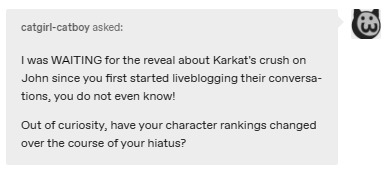
Nothing's really changed since I've been gone! I make a conscious effort not to do much Homestuck analysis off-blog, since I want my journey to be fully documented here.

It's good to be back! I'm looking forward to a full reread when I'm done.

Would you believe I didn't even know there was a book?
I also didn't know the movie had two (allegedly) terrible sequels, which is very funny. Neverending story indeed.

Thank you! I can't take too much credit, though - most of my tagging system has been crowdsourced from askers!

At some point, before we reach the end of the comic, I'm going to have to formalize my approach to liveblogging Homestuck's side content.
What I'll probably do is give each of them the 'lite' treatment initially, but if they turn out to be more canonical than I thought, or particularly interesting to liveblog, I'll 'zoom in', and analyze them properly. We'll see how we go!

Could you imagine the relationship dynamics in your average troll soap opera? The shipping web for a single season would make our heads explode.

It's a fun question. What sort of object symbolizes everything?
The first thing I'd try would be a star chart, Dave's magnifier and a literal planetful of Grist.

Added to the list! Not until later later on, though - I'd worry that the opinions and theories of another liveblogger could interfere with my own, especially if they're talking about it with someone who's already read it!

I would find it hard to disagree.

Do people think Act 1 is pointless?
I mean, it is the slowest Act in terms of pacing, but slow pacing isn't always a bad thing. You sort of have to take it slow when your readers have this much to get to grips with.
...okay, maybe we didn't need quite as many Sylladex mishaps as we got. But we still needed some. Homestuck has a lot to introduce you to.

I always pictured an English accent for Hass - although, interestingly, I didn't picture one for Jade. As a headcanon, I like the NZ one better.
Where did Grandpa grow up again, actually? He was raised by Fake Mark Twain, who was from Missouri - but I don't have a clue what a Missouri accent sounds like, let alone one from a century ago. I have a funny feeling that it's not the accent I'm imagining coming from Jade.
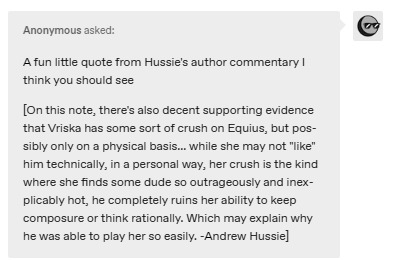
Now that's a ship I'd never have seen coming. Props to Hussie for coming up with something more controversial than my Feferi<>Equius.

All four kids, with four endgame weapons, might be able to challenge Jack's current incarnation - but they're not going to get the chance. You've hit the nail on the head - he's semi-perfect Jack for a reason.
I have several theories for Jade's prototyping, and every single one of them would make Jack even more dangerous than before. It's just barely possible to challenge him now, but things will only get worse.


Read the room, Serket!
Would Vriska have tried to negotiate? She feels like the type of person who'd rather take a beating than admit they're outclassed. Plus, I'm not sure how much she'd have to offer Aradia, who seemed entirely motivated by revenge (and, possibly, secretly motivated by timeline stuff).
All that said, I would have loved to hear Vriska trying to worm her way out of this.

I love it! Please send in the completed house, if you get the chance. That's going to look so cool with a moving meteor.

And they're both easily distractible! This feels like two people who might actually get on surprisingly well, if they were in, say, the same high school class.

It's hard to say what's a rarepair, since I don't know what ships are rare in the fandom - although I'd have a few guesses about the most common ones.
If we're going for a ship with very tenuous connections, I will submit Rose x Feferi for your appraisal. They're both fans of the Noble Circle, and their signature colors are pretty close.
You know what, I'll just review all of your ships. Tavros/Gamzee - PB&J - is pretty cute. [] I'd recommend Miracle Child for a number of reasons, but it does include a well-written Gamtav. Jack/Droog is more <> to me than it is <3. Like One Sundered Star might be influencing that? I'm not really sure. Somewhere I think I saw a Jack<>Droog. Your pre-shipping chart post isn't in the chrono; also, I'm pretty sure the A6A6I5 ask is one of mine. Gamzee/Eridan is a rarepair; I've seen it, but not often, and it's a <> in the fic I'm referencing. Kanaya<>Terezi and Feferi<>Vriska are strange enough that I've never seen them anywhere, really. [] And finally, Vriska and Tavros. These two are the textbook example of why the ashen quadrant needs to exist, and they're a perfect pair for it. [] ~LOSS (8/1/23)
I don't even know if Carapacians have moirallegiance - but those two would definitely work if they did.
Out of all my ships you flagged as rare, I think my favorite is Feferi<>Vriska. I just think they'd gel weirdly well together!
63 notes
·
View notes
Text
youtube
Hello again, podcast side of Tumblr.
This time around, I did a video on Ethics Town, a relatively new cosmic horror podcast about a British valley town where nothing is quite as it seems. Right now Ethics Town is a terribly underrated series, so this video is both my analysis of it, and also my attempt at getting more people to listen to it.
Anyways, yeah, watch the video if you want, or not, it's up to you I guess. If you want to, though, I really do suggest you take the less than four hours and actually listen to the podcast, it's well worth your time.
SPOILERS FOR ETHICS TOWN SEASON ONE BEYOND THIS POINT. CONTINUE READING AT YOUR OWN RISK. / / / / / / / / / /
As with the last post, I also want to share the art from the video. For the first one, I wanted to do something that captured the feel of the Ethics Town logo, which is all black and white and red, so I stuck with a pretty monochromatic colour palette here. The image depicts the Mayor of Ethics, Ian Jacobs, moving the wrapped body of Natascha Flynn to make space for a nearby factory's planned expansions. It was one of two scenes I considered, and I think this was the much better option. The skyline in the background, while not perfect, is meant to mimic the same skyline seen on the Mayor's hat in the logo. The other weird detail here is that everything was done linelessly, which was very weird for me, because I thought it created an interesting look. Oh, also, yes, I did give Ian a ponytail.
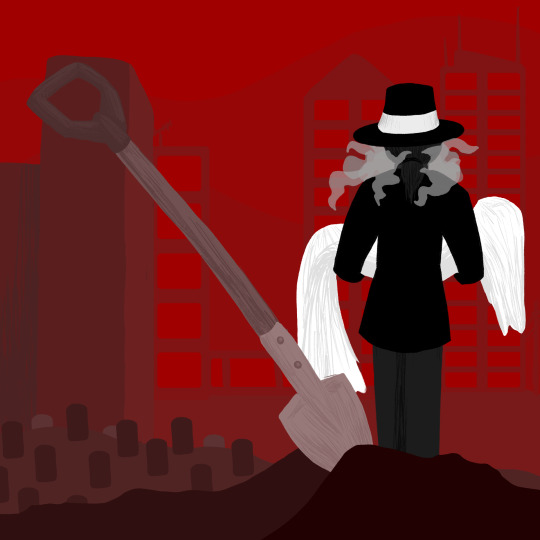
The other art piece is a sketch of Ian Jacobs and January Johnson, because I wanted to experiment with how much I could push their designs before they stopped looking like the same person. I also wanted to have their outfits at least be a little similar, so both of them have outer coverings closed around the middle of the chest around a shirt beneath, and both Ian and January have black headware. I considered giving January a white band on his headphones, but it just wound up getting lost. Another notable difference is in the hair, which I imagined here as blonde, probably in a more platinum direction, though you can't tell that very well from the greyscale. Ian's hair is pulled back in the aforementioned ponytail while it's left loose when he's acting as January. January also has a little more stubble, and his eye bags sag a little more. Finally, even though I only really had two colours to work with, I wanted to try expanding on how he acts within each role using the clothing. January's clothes are lighter, thanks in big part to the grey and white striped hoodie, which is designed to make him seem more emotionally truthful than he actually is. Underneath that light tone, though, is a plain black tee, which ties him to the darker colour scheme of Ian and also hints at the fact that, below his friendly and approachable personality hides the dark secret that he is, in fact, the Mayor who has been making such terrible decisions. Going back to the sweatshirt, the grey and white striping is also slightly reminiscent of the stripes on prison jumpsuits, which is a way of representing his feeling of being trapped into bad decisions and being ensnared by Ethics and his secret role as Mayor. Speaking of the Mayor, Ian is a lot simpler. I considered giving him a big, slightly cartoon-y MAYOR sash, but I wound up preferring how he looks without it. Generally, I tried to keep his wardrobe darker and more formal, and, of course, I had to include the fancy hat we see on the logo of Ethics Town. I also reduced the amount of vape cloud around him for two reasons. First, the in-story reason, is that Ian has accepted who he is and the role he plays in the "narrative" of Ethics, so I imagine he's a bit less stressed. It also works really well metaphorically, though, because he's not disguised anymore. When we see Ian at the end of "The Identity Issue," the mask is fully off. Artemis knows exactly who he is, which means that his identity doesn't have to be clouded by as much smoke. Oh, also, it's a cosmic horror podcast, so if I didn't put something tentacle-esque around the main antagonist, there would be problems.
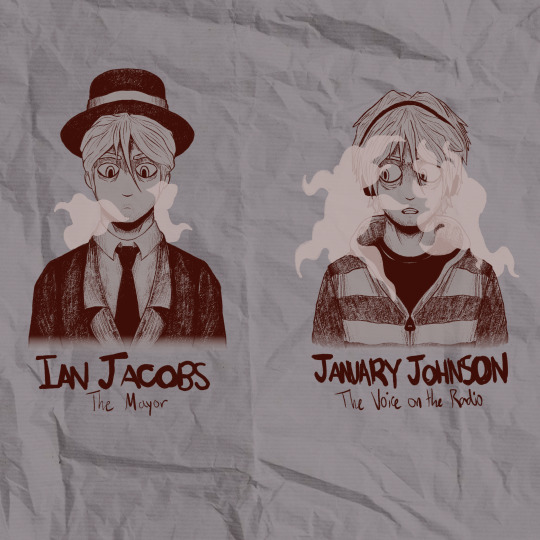
And I think that about covers it. I had a lot of fun listening to the podcast and making the video, and I hope it can bring joy to y'all as well. Catch y'all next time around for The Buried Explained!
#Ethics Town#Ethics Town Podcast#Ethics Town Spoilers#fiction podcast#podcast recs#horror podcast#audio drama#cosmic horror#podcast recommendations#podcast#oh also art i guess#philosophy#morality#ethics#youtube#youtube video#Ian Jacobs is one of the best written characters in fiction#January Johnson#Yeah still don't know how to use Tumblr#Also I forgot about a detail but I asked them if it was intentional on Twitter and apparently it was so yeah Ian is derived from Janus/Ianu#Youtube
23 notes
·
View notes
Text

ART CRITIC PAPER
Title: Candle Vendors
Artist:Vicente Manansala
Medium: Painting
Date: 1977
Introduction
Candle Vendors (1977) by Vicente Manansala is an artistic blend of cubism and the cultural elements of the Filipinos, an oil in canvas. This artwork reflects the everyday life of the people of the Philippines by Manansala. This artwork portrays the four women selling a candle, reflecting the artist connection to the culture and his use of cubism. It explores the intricate pattern, vibrant colors and the culture of the people mixed in the painting, it also reflects the life of the people at that time, this artwork is conveying a story of the life of the Filipino.
Details
This artwork is a captivating oil painting of Vicente Manansala,portraying the Cubism's unique approach, created in 1976. It is portraying three women selling candles in a market place, beside a hallway heading to darkness. The three women are facing front with the use of the shadows and light to emphasize the subject of the painting. The intricate design of this artwork are the lines that creates an illusion of an abstract painting rather than cubism, another is the color palette used, an intriguing color scheme that emphasizes the arts details that gives life to the painting.
Formal Analysis
This artwork of Vicente Manansala called the”Candle Vendor” is an example of his masterful clear cubism technique. The is focused on the four women selling candles at a market, with two women looking at the front and two which looks the other way. Showing the contrasting colors by using shadows to highlight and the angles of the subject to show the important details like the expression of the face, and the way the corridor is from a wider part to getting smaller that heads to a dark area, emphasizing a movement that emphasizes the Cubism technique. The colors that are clearly present are the brown, black and white from the corridor, the red and white from the candles and the green with red and white in the outfits of the women. He used the light and dark colors to contrast one another and emphasize the shape and lines that focus on the subjects and creating a spacial dynamics . Manansala used the space by placing the figures within view with light, also within the shadow and hidden making it appear real and intriguing.
Interpretation
This artwork of Vicente Manansala explore the culture and identity of the Filipinos through the use of cubism. The paintings description about the women selling the candles, is a picture of the spirit and strong Filipino people. There are some reflections, like the women selling candles that reflects the determination and struggle in the everyday life of the people, it also highlights the economic of the Philippines. The candles is a representation of hope that encourages their lives. His use of the Cubism technique, connects the modern and traditional theme of the art. The various perspective shown in the artwork invites the viewer to see it in different angles, showing the complex life of the Filipino people. The color palette of the painting suggest an alluring and sentimental approach for the viewers of the art. The expressions of the women evoke a sense of dignity and strength as they work hard. This art piece is a multi-layered art full of culture and tradition of the Filipino life.
Judgement
The elements within this art are showing a unity within the painting. With the geometrical shapes that makes an illusion of an abstract painting, with just the shadow and light that creates an emphasis and depth to the artwork. The shades of the color present in this art provides a peaceful ambiance, but also a dignifying one that draw’s an attention. This arts theme vary from interaction and connection by showing the different angle of the women selling candles, with this depiction in the art we can say that they shared an activity in different angles and contrasting colors that interrelates it all together. This pieces light and shadows, symbolism within and the color palette interrelates to one another to create a unity and making it intriguing to the viewers.
Conclusion
The artwork of Vincent Manansala called “Candle Vendor” is a combination of modern and traditional culture and techniques. Through his use of the Cubism method, Manansala shows the everyday life within the Philippines, that focus on the spirit and and strength of the people. This is a composition of contrasting colors, harmonious vibe, and symbolism interrelate to one another, creating an impact and connecting with the viewers.
Francine's 12th Blogging Entry: Literacy
3 notes
·
View notes
Text
Sitting on the South Lawn of the White House on Sept. 13, 1993, I couldn’t believe what I was seeing. Under a brilliant, cloudless sky, an uncomfortable Israeli prime minister and a beaming Palestinian leader clasped hands in pursuit of peace as an exuberant U.S. president embraced the duo, smiling like a proud parent.
The occasion was the signing of the first agreement of what came to be known as the Oslo Accords, which established an interim framework that, if implemented successfully, might actually lead to final status negotiations between Israel and the Palestine Liberation Organization (PLO). Even with all the challenges that lay ahead, I was convinced that the Arab-Israeli peace process was now irreversible.
Efraim Halevy, who in just a few years would become the head of Mossad, Israel’s intelligence agency, would later write to me questioning my faith in that irreversibility and fearing the confrontation that could follow. Halevy’s analysis proved all too prescient. Today, 30 years after that historic day, what remains of the spirit and much of the substance of the Oslo agreement lies bloodied, buried, and betrayed across an Israeli-Palestinian landscape that seems to leave little room for hope and none for illusions.
The most right-wing and fundamentalist government in Israel’s history sits in Jerusalem, committed to the annexation of the West Bank in everything but name only, as well as expanding settlements and enabling settler terror and violence against Palestinians. The Palestinian national movement is deeply divided, resembling a kind of Noah’s Ark where there are two of everything—constitutions, governments, security services, patrons, and even visions of Palestine. In Gaza, Hamas and Palestine Islamic Jihad plan and encourage terror attacks against Israelis, while in Ramallah, a weak and discredited Fatah-dominated Palestinian Authority is unable or unwilling to control terror emanating from the northern West Bank.
Yet the lessons of Oslo still have some relevance, whatever the future holds for Israelis and Palestinians. Having had a ringside seat during those fateful years, four key takeaways stand out for me personally.
1. Interim can’t be final.
On paper, the Oslo Accords seemed logical and compelling. Territory would be transferred gradually to the Palestinian Authority in exchange for its assumption of security responsibilities. As we’ll see, the perverse dance between the occupier and the occupied would doom this approach. But it might have survived had the two sides been willing to make it clear from the outset what final outcome the interim period was supposed to produce, and then taken mutually reciprocal actions on the ground to prepare for it.
For Palestinians, that final outcome was an independent state with Jerusalem as its capital. For Israelis, it was TBD—to be determined. Driven by domestic politics and their own doubts about the Palestinians’ capacity for statehood and what it might mean for Israeli security, neither Israeli Prime Minister Yitzhak Rabin nor his successor Shimon Peres were prepared to commit to any agreed outcome—even as an aspirational vision. You can look long and hard for the term “Palestinian state” in the Oslo documents, but you won’t find it. It would take another half-dozen years before the idea of statehood worked its way into Israel’s negotiating assumptions. Not until 2001, as U.S. President Bill Clinton left office, did the United States formally and publicly articulate support for a two-state solution.
With no clear end goal to work toward, the process floundered. By 1999, not a single Oslo deadline had been met. Negotiations on permanent status had begun three times but produced nothing, and neither Israelis nor Palestinians could see where things were headed. But both had grown weary and wary of a seemingly never-ending interim process punctuated by Palestinian terrorist attacks and Israeli settlement expansion.
The result was the situation we have now: a strategic cul-de-sac in which the two sides are stuck and the gaps on issues such as borders and Jerusalem are as wide as the Grand Canyon, with no shared vision and no faith that one will ever materialize.
2. Leaders—and not just their negotiators—have to be willing to yield.
It seems like another world now given the state of relations between Israelis and Palestinians today, but back then, the negotiators for both sides actually worked hard together to solve problems and manage the ones they couldn’t. It was less so for the leaders who had to deal with the politics of the negotiating process and defend what they could—and punt and parry the issues they couldn’t.
In the early Oslo years before Rabin’s murder in November 1995, the Israelis and Palestinians doing the negotiating laughed, yelled, and cried together against the backdrop of a roller coaster environment that included agreements, missed deadlines, Palestinian and Israeli terror attacks, and continuing frustrations and suspicions. They became friends. I saw security officials from both sides—hard men with blood on their hands—engage with one another with respect and even affection. At one negotiating session at the Laromme Hotel in Jerusalem, an exhausted West Bank security chief Jabril Rajoub laid down in the same bed with Israel Defense Forces’ central commander Shaul Mofaz, jokingly pretending to take a nap.
For the negotiators, Oslo was not about zero-sum advantage but mutual benefit. That view was best embodied by Oslo’s two lead negotiators, Uri Savir and Abu Ala (both of whom have since died), who would become fast friends. Interviewing them both in 2013 on the 25th anniversary of Oslo, that sense of partnership was front and center. Abu Ala, also known as Ahmed Qureia, opined about the promise Oslo held: After decades of bitter struggle, during which both saw each other only through a barrel of a gun, they realized that it is possible to overcome hatred, misgivings, denial, and their own red lines. Neither man was a dreamer, but both saw the opportunity that Oslo offered to better understand the needs of the other and to humanize the adversary.
I sometimes thought that, had the decision-making been left to Abu Ala and Savir, Oslo would have had a better chance of delivering. But in the hard and cruel world of Israeli and Palestinian politics, leaders had their own personal and political constraints with which to reckon.
For Rabin, dealing with the Palestinian issue was never his first choice. It is true that as defense minister during the First Intifada, Rabin began to understand that the conflict had no military solution, and by the spring of 1993, he had reached the conclusion that no one—not Jordan, not West Bankers, not Gazans—could replace the PLO as an interlocutor. But peace with Syria was his preference because of its strategic character and its avoidance of hot-button issues such as Jerusalem. Then, in August 1993, with the U.S.-mediated Israeli-Syrian channel making progress but with little chance of a dramatic breakthrough, the secret Oslo channel delivered—and suddenly, Rabin was thrust into dealing with the Palestinian issue head on.
In the Oslo Accords, Rabin made a historic decision with respect to the Palestinians. But translating that to an Israeli bureaucracy and security establishment that held the key to making life better for Palestinians on the ground proved much harder. By 1993, the policies of the Israeli occupation had become deeply entrenched in Israeli politics and day-to-day relations with Palestinians.
Rabin had also locked himself into a public commitment not to dismantle any settlements during the interim period, and to do so only as part of a permanent status negotiations. He would later regret that decision when, in the wake of an Israeli settler massacring 29 Palestinians in Hebron, he resisted pressures from within his own government to remove the 400 settlers living there who required a large Israeli military presence to protect them. Rabin was fearful of reaction from the right-wing opposition and worried that Yasser Arafat, then the chairman of the PLO, would exploit the crisis to push for an international presence in the West Bank. Yet Rabin’s unwillingness or inability to limit, let alone halt, settlement expansion diminished Palestinian willingness to implement their own commitments under Oslo.
As for Arafat, I was never really sure of his motives for accepting the Oslo Accords. They compelled him, at least for the moment, to recognize Israel without achieving any of the Palestinians’ demands—not self-determination, not statehood, not East Jerusalem as a Palestinian capital, not the right of return for Palestinian refugees. My best guess is that for Arafat, Oslo represented Israel’s, the United States’, and the international community’s validation of himself and the PLO as the only legitimate avenue for dealing with the Palestinians. Arafat put up with the interim process because, in essence, the entire world recognized him as the exclusive address for all matters Palestinian. It was the triumph of personal ego over national interest.
But Oslo proved to be the first and last concession that Arafat was prepared to make. In March 2002, during a mission with the George W. Bush administration’s special envoy, Anthony Zinni, we saw Arafat at his headquarters surrounded by Israeli forces. Entrances barricaded, windows blacked out, candles on the table lighting an otherwise darkened conference room, there was Arafat with his black machine gun on the conference table, talking about martyrdom for the cause of Palestine.
He had come a long way, but could never quite make the transition from the mentality of a revolutionary leader committed to armed struggle and the use of violence against Israel to the world of compromise and diplomacy that would have been required, together with a foresighted Israeli leader, to bring about the end of the Israeli-Palestinian conflict.
3. The occupier and the occupied aren’t equals in negotiations.
The good news about Oslo was that Israelis and Palestinians had managed to hammer out a substantive and complex agreement between themselves directly, face-to-face. It’s like that old adage: In the history of the world, nobody has ever washed a rental car. Why? Because folks only care about what they own. Oslo was an example of authentic ownership. Agreement was reached because the parties themselves had a sense of urgency and a need for their own interests to come together without external pressure.
But the Israeli and Palestinian dual act was also bad news because of the power imbalance between the two parties: one the occupier, Israel, and one the occupied, the Palestinians. Given this reality, it was remarkable that anything got done at all in terms of territorial transfer, economic and security cooperation, and building Palestinian institutions.
The asymmetry of power was clear: As the occupier, Israel wielded the power of the strong—the capacity to impose its will on the Palestinians. This took the form of everything from settlement construction, land confiscation, and housing demolitions to closures of the West Bank cities and towns (preventing travel), and targeted killings. Settlement construction was especially egregious, with 115,700 Israeli settlers residing in the West Bank and Gaza at the end of 1993; by mid-1999, that number had risen to 176,973.
Palestinians, on the other hand, wielded the power of the weak: terrorism. As the weaker party in the negotiations, Palestinian leaders rationalized the use of terror and violence and the armed struggle against Israel as an acceptable instrument to fight back against Israeli occupation and the ongoing settlement expansion. Even though most of the terrorist attacks in the early Oslo years were carried out by Hamas and Palestine Islamic Jihad outside of the Palestinian Authority’s control, Arafat—who never abandoned the use violence as potential tool—could or would not do more to prevent terrorist attacks or arrest the perpetrators.
From Israel’s perspective, land was transferred to the Palestinians, yet the terrorism continued, raising questions about the PLO’s reliability. From the Palestinian perspective, Israel had put Palestinians on probation. Israel was appropriating land that Palestinians believed to be theirs, and any confidence-building measures were only offered in return for Palestinian performance and good behavior. These mindsets produced a barrier that, in the absence of a third party that could help balance the power asymmetry and press each side to implement their commitments, proved insurmountable.
4. A mediator must be present—and credible.
In many respects, the early years of Oslo were a U.S. negotiator’s dream. Israelis and Palestinians had finally done what we had been encouraging them to do for years: get together and work through their own problems themselves. Rabin briefed U.S. Secretary of State Warren Christopher on the outlines of the Oslo breakthrough in July, minus the mutual recognition package. But neither Rabin nor Arafat wanted Americans in on the substance—Rabin wanted the United States involved only to pressure the Palestinians but was wary that the Americans might adopt a pro-Palestinian position, and Arafat was concerned they’d side with the Israelis.
And so, in the early years until Rabin’s murder in late 1995, Washington’s role was limited to hosting signing ceremonies, rallying donors, and playing firefighter at critical points when negotiations reached a crisis—such as when a terrorist attack occurred, or when Israeli settlement expansion or other unilateral acts threatened the process. What the United States didn’t—and couldn’t—do, largely because of Israel’s objections, was create the one thing that might have actually given the Oslo process durability: a monitoring mechanism to hold each side to the commitments they had made and, if necessary, impose costs for a breach.
Doing so was a bridge too far. This was partly because of the United States’ traditional special relationship with Israel, which made getting tough with the Israelis, especially on settlement expansion, off limits; partly because of the Clinton administration’s determination to improve relations with Israel after the stormy years of former President George H.W. Bush; and partly because, when it came to Oslo violations, terrorist attacks were understandably viewed as more lethal than settlement expansion and pushed the United States to side with Israel.
From Oslo on, with Rabin’s pro-peace successor Peres and especially with Ehud Barak at the Camp David summit, Clinton didn’t want to jam up Israeli prime ministers. Far too often, Americans—myself included—essentially acted as Israel’s lawyer. What this meant in practice was a disposition favoring Israel on process, substance, tight coordination, and no surprises.
I’ll never forget: On the fourth day of the summit, I saw the late Palestinian negotiator Saeb Erekat on one of the walking paths. He stopped and asked when the Palestinians were going to receive the draft of a paper that we were preparing on the core issues. I said it was taking more time to prepare than we thought. Smiling, Saeb replied, “Aaron, you’ve given it to the Israelis first, haven’t you?” I smiled back and kept on walking.
In the wake of Rabin’s murder, the United States tried to take a more active role. From 1995 to 2000, working with Arafat and two Israeli prime ministers—Benjamin Netanyahu and Barak—Americans were able to keep the process alive, broker three interim accords, and strengthen Israeli-Palestinian security cooperation, with the CIA working directly with the Palestinians. But the same structural factors that made Oslo a long shot even in the heady days of the fall 1993—the absence of an agreed political vision, the perverse dance between the occupier and the occupied, and terrorism and settlements—were simply too much to overcome.
And what proved to be an ill-advised and ill-conceived summit in July 2000 at Camp David, however well intentioned, could not redeem what had already been lost.
In the 30 years since the Oslo Accords, Israeli-Palestinian peace turned out to be anything but inevitable. Looking back, Oslo represented a moment when Israelis and Palestinians came together in hopes of securing a better future.
Paradoxically, talk of potential Israeli-Saudi normalization has revived a key concept of the Oslo process focusing on the so-called Area C, which constitutes 60 percent of the West Bank and is where most of Israel’s settlements are located. There are credible reports of various proposals made by the Palestinian Authority, the United States, and Saudi Arabia arguing that Israel should agree to transfer a significant portion of Area C to Palestinian control as part an agreement between Riyadh and Jerusalem to normalize relations.
Such a proposal will almost certainly be resisted by extremist ministers in Netanyahu’s government, and it’s unclear how flexible Netanyahu—who is desperate for a deal with the Saudis—will be. Still, it would be quite extraordinary if the presumed dead and buried architecture of the Oslo process was resurrected to try to redeem the fast-fading hopes of progress on the Israeli-Palestinian track.
But even with this potential opening, there’s still no clear pathway to end the conflict, and no organizing principle around which a majority of Israelis and Palestinians can rally. Without giving up hope—and we cannot—we also should not succumb to facile illusions and assumptions about silver bullets that can redeem a peaceful future for both peoples. If Oslo demonstrated anything, it’s that even with leadership and partnership, the journey is long, hard, and strewn, more often than not, with failure.
None of this means that the past is inexorably prologue. None of us can see around corners, and abandoning the search for an equitable and durable Israeli-Palestinian peace is neither morally nor ethically responsible—and it’s not in U.S. interests. We need leaders who see peace as critical to their own people and who are prepared to understand and work to accommodate the needs of the other side; a mediator who’s prepared to be reassuring, patient, and tough on both sides when necessary; and an end state that recognizes that a durable and equitable solution depends on a balance of interests, not an asymmetry of power.
None of these things is available now. Yet the United States may someday have another opportunity to pursue Israeli-Palestinian peacemaking, and we should do so without illusion and without believing we can do it alone or abandoning that pursuit if we run into serious challenges. And with right-thinking and courageous Israelis and Palestinians, support from the Arab world and beyond, and a fair amount of luck, one day—who knows—we might just get there.
10 notes
·
View notes
Note
so what is your thesis?
Oh, that’s a joke on my part. Mostly. To call it a “thesis” exaggerates the level of formality involved. I’m just bitching about the scope of the work, which I feel entitled to do because my insistence on pursuing this is less a function of personal choice than personal pathology.
Regardless, it IS intended to address the lack of interdisciplinary synthesis on a literature graduate and polymath whose formative influences are known to preempt his interest in film by at least 20 years. Mann's approach to filmmaking — in structure, in semantic ambition — is grounded in a literary systems analysis that he quite literally inherited as the descendant of Russian/Ukrainian Jewish émigrés; that would soon later reach a fever pitch in American English departments in the form of its descendants when he was a student. And like, in fairness, it took Mann being like "Heat is my Faust. By the way ;)" before I myself was like "OOHHHH" and simultaneously zoomed in and zoomed out to examine his work at the requisite resolution(s). I've been tugging at threads ever since to see what unravels and what leads me closer to the center of the labyrinth.
The irony is that the film literature has mostly missed the trees for the forest, and the forests for the biome. In the same way that Goethe had to iterate upon the constituent structure of Faust in order to "bring current" and encapsulate a more complete historical and referential sphere for its mythic content, Mann is using the component forms of cinema — its emergent technological and visual language, right down to grammar and syntax — to chart the "becoming" of a new postmodern age, its grand crises of meaning and morality. To quote Goethe: "Content brings form with it; form is never without content."
This is, for example, why you have Pacino and De Niro playing the roles that they do in Heat; why Heat exists in no fewer than four different evolutionary stages; why Tom Cruise was cast as Vincent in Collateral and why the film was shot digital (also why Mann initially considered casting a woman as Vincent!!!); why every last detail down to the buttons on a suit jacket or a "psychotic kitchen chair" brokers his consideration; why he hates the S-word; why every one of his actors receives a complete backstory and life history for the character; why he CUTS AND RE-CUTS AND RE-CUTS AND RE-CUTS FOREVER AND EVER FROM EDITION TO EDITION... I could go on. He's not just an auteur, he's the ur-auteur. The inter-text is the text, and there is nothing outside the text, for him maybe more than anyone else.
14 notes
·
View notes
Text
How I Purged My Entire Closet in 48 Hours (PT.1: Preparing for a Purge)

TL;DR:
Step 1: Do ALL your laundry. Step 2: Sort your clothes into broad categories and write them down. Step 3: Decide which categories you're purging today. Step 3.5: Put everything you're not purging out of sight. Step 4: Purge.
But if you want to know all the details of how I made it go so quickly for my neurodivergent self, here are the real steps to purging an entire closet.
The Real Steps to Purging an Entire Closet
Real Step 1:Understand how your brain categorizes your clothes.
Take a look at where you currently keep your clean clothes or how you aspire to store them. Are your socks and underwear crammed together in the same space, making it difficult to find the pizza patterned socks you really want to wear today? Apply the same concept to other clothing items as well. For example, if you have multiple styles of shirts mixed in the same drawer, it can lead to mental overload and analysis paralysis. Real life example:
Before my clothes purge, all my shirts from crop tops to casual long sleeves were crammed into the same drawer. This chaotic system didn't work for me because I rely on visual organization. If things aren't visible at first glance, they might as well not exist. Real Step 2: Categorize your clothes!
Here's my primary categories and subcategories: Tops Crops (sleeves of any length) Tanks Tees Nice Short Sleeves and No Sleeves Formal Short Sleeves and No Sleeves Casual Long Sleeves Nice Long Sleeves Formal Long Sleeves Exercise Bottoms Short Shorts Shorts Long Shorts Capris (purge category) Jeans Casual Pants Formal Pants Exercise Intimates Bras Sports Bras Underwear Boxers Socks Thigh High Mid Calf Above Ankle Ankle Tights Bathing Suits Masc Suits Fem Suits Secondary Warm Layer Sweaters with buttons Sweaters without buttons Hoodies Dresses (Sorted by formality) Skirts (also sorted by formality) Officewear, Etc. Coats Exercise Raincoats Vintage Winter Casual Accessories such as shoes, belts, hats, jewelry, as complementary items, are their own beasts and will be addressed separately after purging the bulk of clothing. The key aspect of Step 2 is that the bolded categories are planned and intentional, while some subcategories emerge organically as I take stock of my belongings and determine their appropriate spot.
Example of planned vs organic subcategories:
For intimates, I utilize a plastic chest of drawers. The top drawer is reserved for bras, the middle one for underwear, and the bottom one for socks. Purging according to these categories, one at a time, was part of my plan.
On the other hand, regarding tops as referred to in Step 1, I initially stored all of them in the same drawer. However when I had them all on the floor in front of me during the purging process…

The twelve piles pictured organically developed.
The bottom left pile consisted of items to be hung up, including long sleeves that didn't belong in that drawer to begin with, and nicer short and sleeveless tops. The three center piles were t-shirts sorted by level of "formality," while the six piles on the right were tank tops and crop tops. Why Categorize and Subcategorize Before Purging? Addressing similar clothing groups individually is far less overwhelming than tackling the entire "shirts" category at once. This approach allows me to evaluate each shirt as part of my wardrobe, going beyond a simple decision of whether to keep or discard it.
For instance, I categorized together these four functionally identical shirts (tops/short sleeve/nice but not formal/neutral):

If I had sorted "Tops" as a whole instead of categorizing first, I might have kept all four without realizing that two of them were similar enough to purge. By considering the specific subcategory, I was able to identify the factors that led me to purge the two on the left in favor of keeping the more flattering V-neck style in a much better condition.
Breaking down the process into manageable clothing categories before tackling allowed me to evaluate each item based on its function and relevance to my wardrobe, rather than feeling overwhelmed by the sheer volume of clothing or missing near-duplicates. In Part 2 of "How I Purged My Entire Closet in 48 Hours," I'll elaborate on how I purged based on the most flattering colors and cuts that complement my personal style, referencing seasonal color analysis and the Kibbe system.
#closet purge#closet#Neurodivergent Closet#Closet Purge Guide#Sensory Friendly Closet#Functional Wardrobe#Organized Living#Personal Style Journey#Closet Transformation#ADHD Closet Purge#tarnnl
2 notes
·
View notes
Text
How You can Make use of a Matchmaking Company: A Step-by-Stage Information to Acquiring Really like
While in the age of digital relationship, where swipes and likes dominate the hunt for adore, matchmaking companies offer you a customized and efficient option. These services, operate by Qualified matchmakers, provide a curated method of locating significant relationships. But how do you make the most of the matchmaking support? This stage-by-action information will walk you thru the process, helping you know how to use a matchmaking assistance to seek out your excellent match.
Action one: Exploration and Pick the Ideal Matchmaking Assistance Before diving in to the matchmaking approach, it’s vital to pick the correct assistance for you personally. Below’s how:
Determine Your requirements: Identify Whatever you’re in search of in a connection and what sort of service satisfies your lifestyle. Have you been seeking area matches or are you open up to extended-distance associations?
Analysis Companies: Try to look for matchmaking services with excellent reputations, favourable assessments, in addition to a demonstrated track record. Consider things including expertise, consumer recommendations, and success tales.
Consultations: Several matchmaking expert services offer cost-free Original consultations. Use this chance to request thoughts, have an understanding of their process, and see if their strategy aligns with your preferences.
Action 2: Preliminary Consultation and Profile Creation After you’ve chosen a matchmaking provider, the method commonly starts by having an in-depth session.
youtube
Personal Session: All through this session, the matchmaker can get to know you. Be ready to examine your romance history, particular preferences, values, and That which you’re seeking inside a partner.
Honesty is vital: Be open up and trustworthy in the course of this session. The greater accurate and specific your info, the greater your matchmaker can discover acceptable matches.
Profile Creation: Depending on your session, the matchmaker will create a detailed profile that highlights your character, passions, and marriage ambitions.
Step three: Match Variety and Vetting With your profile in hand, the matchmaker will commence the entire process of picking probable matches.
Match Choice: The matchmaker will use their skills and database to establish people who align together with your requirements. This process requires watchful vetting to be sure compatibility.
Qualifications Checks: A lot of matchmaking providers perform qualifications checks on probable matches to be certain protection and authenticity.
Stage four: Introductions and Dating Once acceptable matches are discovered, the matchmaking company will aid introductions.
Introduction Preparations: The matchmaker will arrange introductions, which may be in the shape of casual meetups, formal dates, or Digital meetings, based on your choice.
Initial Assembly: Strategy the initial Conference using an open up brain and a constructive Mindset. Recall, the objective is to discover if there’s prospective for your further link.
Action 5: Suggestions and Ongoing Guidance Following Just about every day, your matchmaker will Acquire responses to refine the matchmaking process.
Give Responses: Share your views and ordeals together with your matchmaker. What did you like with regards to the match? What may very well be enhanced?
Ongoing Aid: Make use of the opinions periods to have assistance and steering from the matchmaker. Their insights may help you navigate the courting procedure a lot more successfully.
Stage six: Refinement and Continued Matching Based on the feed-back, your matchmaker will continue on to refine the seek out your great companion.
Refined Matches: The matchmaker will utilize the opinions to better have an understanding of your preferences and refine future matches accordingly.
Persistence is Important: Obtaining the right match usually takes time. Believe in the method and keep on being affected person.
Benefits of Utilizing a Matchmaking Support Personalised Attention: Matchmaking providers present individualized interest, making certain matches are tailor-made towards your unique Tastes and identity.
Quality Matches: Concentrate on quality over amount, supplying you with meticulously vetted matches that have a higher potential for compatibility.
Expert Guidance: Qualified matchmakers offer you useful guidance and insights, serving to you navigate the dating environment with assurance.
Time-Conserving: Matchmaking services take care of the legwork, saving you time and effort during the hunt for a appropriate companion.
Summary Employing a matchmaking support might be a transformative encounter in your search for enjoy. By adhering to this phase-by-action manual, you may take advantage of of the personalized and specialist-driven strategy that matchmaking expert services offer. With patience, honesty, and an open mind, you will find meaningful connections and get a major stage toward discovering your perfect match.
Prepared to embark on your journey to like? Start off exploring matchmaking solutions these days and discover the primary difference a specialist matchmaker might make in your search for your soulmate.
Check more info. here: how to use a matchmaking service
#matchmaker#matchmaking#matchmaking service#professional matchmaker#best matchmaking services#matchmaking nyc#matchmaking services nyc#matchmaking services near me#matchmaking service in nyc#matchmaking new york#boutique matchmaking service#how to use a matchmaking service#matchmaker new york#best matchmaker#new york matchmakers#matchmaker nyc#matchmakers#millionaire matchmaker#dating service#new york matchmaking#Youtube
0 notes
Text
Fwd: Postdoc: CER_Hungary.EvolBiologicalInvasions
Begin forwarded message: > From: [email protected] > Subject: Postdoc: CER_Hungary.EvolBiologicalInvasions > Date: 17 May 2024 at 05:12:13 BST > To: [email protected] > > > > CER_Buadapest.EvolutionaryEcology > > Postdoctoral Position in evolutionary ecology of biological invasions > > HUN-REN Centre for Ecological Research (CER) is looking to hire a > Postdoctoral Researcher for 18 months (with a possibility of continuation) > to work on the evolutionary ecological aspects of invasion biology as a > part of the Invasion Biology Division (IBD) of the National Laboratory > for Health Security. > > BACKGROUND: > > The establishment and expansion of non-native species is one of the > great challenges of our time. Invasive alien species are one of the > major drivers of biodiversity loss, which generally negatively affect > the economy and human health. The Invasion Biology Division (one > of the four pillars of the National Laboratory of Health Security, > https://ift.tt/TbpUlah) aims to understand the ecological and > evolutionary causes and consequences of the establishment and spread > of invasive species through a unified approach. Our goals are also to > explore the social and economic consequences of invasions, and develop > methods of prediction and control based on scientific evidence. > > OUR WORK: > > Invasion Biology Division (https://ift.tt/wL0ncVz) > covers all aspects of invasion biology research with a focus on a broad > spectrum of animal and plant taxa. We aim to document and continuously > monitor invasion and spread of various target species that play a key role > in conservation, economic or social terms by applying various methods, > e.g. citizen science mapping, field sampling, taxonomic identification, > genetic screening, meta-analysis and phylogenetic comparative methods. We > intend to reveal the causes behind the success of invasive species by > studying the morphological, physiological and life-history traits and > invasion pathways, as well as to uncover the evolutionary dynamics > of invasion. > > JOB DESCRIPTIONS: > > We are looking for an applicant with a solid background in ecology > and/or evolution who demonstrates interest in the research fields of > Invasion Biology Division and is keen to work on any of the studied > model organisms (see the research topics of different working groups > at https://ift.tt/oqROrML) > > Ideally, we expect the candidate to work on her/his own (but with the > ability to communicate effectively as a member of a team), and could > bring novel concepts/expertise within the research project. As a formal > qualification, the candidate must hold a PhD degree (or equivalent), > and a considerable publication record. > > The postdoc will be based at the CER (https://ift.tt/s4zE3lM), > Hungary's largest ecology and evolution institute, with more than > 200 researchers and a diverse array of research topics. The research > program is incorporated into a larger National Laboratory platform that > establishes strong collaborations with sixteen research institutes > along the One Health concept. The postdoc will work in Budapest or > in Vácrátót (a beautiful botanical garden) and will interact with > members of the other research groups and institutes, but we offer high > flexibility with regard to the working routine. Salary range will be > subject to further negotiations and will depend on professional experience > of the candidate as well as on the requirements of the National Laboratory > program in Hungary. > > To apply, please just send an email to [email protected] with the > following pdf documents as attachments: CV (max 2 pages), cover letter > specifying the applicant’s motivations (max 1 page), one or max two > recommendations suggested. All applications, irrespective of age, gender, > disability, race, religion or ethnic background, are welcome. The deadline > for applications is 15/06/2024. > > László Zsolt Garamszegi > Project leader (IBD) — Director general (CER) > > > László Zsolt Garamszegi
0 notes
Text
Unraveling the Legacy of Unani Medicine in Mumbai: A Time-Honored Tradition in the Heart of the City
Introduction:
In the bustling metropolis of Mumbai, where skyscrapers kiss the sky and the pace of life never seems to slow, there exists a hidden treasure trove of ancient healing wisdom. Nestled amidst the chaotic streets and vibrant culture lies the tradition of Unani medicine, a holistic approach to healthcare that has stood the test of time. In this blog, we delve into the rich history, principles, and contemporary relevance of Unani medicine in Mumbai, exploring its profound impact on the health and well-being of its inhabitants.

Unraveling the Origins of Unani Medicine:
Unani medicine traces its roots back to ancient Greece, where the renowned physician Hippocrates laid the foundation for a system of healing based on the balance of the four humors – blood, phlegm, yellow bile, and black bile. Over the centuries, this ancient knowledge was passed down through the Persian and Arab civilizations, eventually finding its way to the Indian subcontinent during the medieval period.
Leech therapy in Mumbai flourished under the patronage of the Mughal rulers, who valued its holistic approach to health and healing. The city became a hub for Unani scholars and practitioners, with prestigious institutions such as the Hamdard University contributing to its growth and development.
Principles of Unani Medicine:
At the heart of Unani medicine lies the concept of the human body as a microcosm of the universe, governed by the same elemental forces – earth, water, air, and fire. Health is seen as a state of balance between these elements, while disease is viewed as an imbalance or disruption in their equilibrium.
Unani physicians employ a range of diagnostic techniques, including pulse diagnosis (Nabz), urine analysis (Baraz), and examination of the patient's temperament (Mizaj), to identify the underlying cause of illness. Treatment modalities may include herbal remedies, dietary modifications, physical therapies, and spiritual practices, all aimed at restoring the body's natural harmony.
Revival and Resurgence in Modern Mumbai:
In recent years, there has been a renewed interest in Unani medicine in Mumbai, fueled by a growing awareness of its holistic approach and emphasis on natural remedies. As people seek alternatives to conventional healthcare, Unani clinics and wellness centers have sprung up across the city, offering a range of services to meet the diverse needs of its inhabitants.
One such example is the Tibbiya College and Hospital, affiliated with the Aligarh Muslim University, which has been at the forefront of Unani education and research in Mumbai. Here, students learn not only the theoretical principles of Unani medicine online but also gain practical experience through hands-on training and clinical rotations.
In addition to formal institutions, Mumbai is home to a vibrant community of traditional healers and herbalists who continue to practice the ancient art of Unani medicine in its purest form. These healers, known as Hakims, draw upon centuries of wisdom passed down through generations, treating ailments ranging from common colds to chronic diseases with a combination of herbs, spices, and natural remedies.
Challenges and Opportunities:
Despite its rich heritage and proven efficacy, Unani medicine faces several challenges in modern Mumbai. One of the primary obstacles is the lack of recognition and support from mainstream healthcare systems, which often favor allopathic medicine over traditional healing modalities. This has led to a disparity in access to Unani healthcare services, particularly among marginalized communities who may rely solely on government-funded facilities.
Another challenge is the integration of Unani medicine into the broader healthcare landscape, including the regulation of practitioners and the standardization of treatment protocols. While efforts have been made to establish regulatory bodies and licensing requirements for Unani practitioners, there is still much work to be done to ensure quality control and patient safety.
However, amidst these challenges lie opportunities for growth and innovation. With the rise of holistic health movements and the increasing demand for personalized and preventive care, Unani medicine is poised to make a resurgence in Mumbai and beyond. By embracing its cultural heritage and adapting to modern times, Unani practitioners have the potential to revolutionize healthcare delivery and promote wellness for all.
Conclusion:
In the fast-paced urban environment of Mumbai, where stress and lifestyle-related diseases are on the rise, the ancient wisdom of Unani medicine offers a beacon of hope for those seeking holistic and natural solutions to their health concerns. As the city continues to evolve and embrace diverse healing traditions, Unani medicine stands as a testament to the enduring power of ancient knowledge in the modern world. Through education, advocacy, and community engagement, we can ensure that the legacy of Unani medicine thrives for generations to come, enriching the lives of Mumbai's inhabitants and beyond.
0 notes
Text
Author’s intent
Literary analysis is an essential component of high school English classes. It’s a challenge right now because reading and writing stamina are low, as are attention spans. It’s also difficult to balance literary classics with modern literature. This is why I love short stories so much. I’ll address that in my next post.
Today’s debatable issue: how important is authorial intent? I would not dare say it’s totally unnecessary, however can we really know an author’s intent? Isn’t that ultimately a form of conjecture?
My favorite professor from High Point University said this:
Ben, That's a raging question these days. My answer is that a writer has no control over the interpretation of his/her poem, which will always be filtered through a reader's intellectual background, experience, and feelings. I'm a poet with four books; I give readings often in North Carolina. I am delighted by the range of reactions conveyed by listeners and readers. Some are stunningly perceptive; others discover nuances I never imagined were in the poem; some seem irrelevant. When a poem leaves my hands, it belongs to others. I do not want to limit their responses to what my intention was. Ben, sometimes I don't know what I mean to do in a poem. I start with an image, a snatch of dialogue, or a memory. My poetry rises from life, not from ideas. It often leads to strange, unanticipated places. That's good. When you develop thoughts, you are writing essays or sermons. Poets don't sit down and think, "Now what do I want to say?" When you follow a trail in the woods instead of a train of thoughts, you never know where the trail is going until you get to the end. It could be a fork and the road not taken; it could be a pregnant deer wounded by a hunter; it could be the ghost of your grandfather saying, "It's time for us to talk." Poetry is not pro forma; paint by numbers. Now here's the flip side: Formalist critics like T.S. Eliot and the Fugitive School argued that an analyst needed to restrict interpretation to the words of the poem, to what was on the page. They emphasized formal analysis instead of the author's biography, history, or personality. I admire this approach until it becomes too rigid. I think everything should be taken into account, beginning with what's on the page and then considering outside factors. No real poet would ever want to insist that a poem means one thing and one thing only or that the poet's intention must be exalted above all. The Formalists called focusing on an author's intention "the intentional fallacy." I think you should stress what's on the page but be willing to move outside the poem for influences, etc. If you google me, you can find some of my poems in journals. If you want to ask me about my intention in a specific poem, I'll try to answer and to mention where the poem went….Congrats on your teaching career. You were a sharp, energetic student--a pleasure to talk with.
#literature #books #analysis
1 note
·
View note
Text
How to Become a Certified Business Analyst

Certified Business Analyst can be a rewarding and transformative experience. In a world where businesses are constantly evolving, the role of a business analyst becomes crucial for success. Whether you're a recent graduate or a professional looking to switch careers, this guide will break down the steps to help you navigate the path towards becoming a certified business analyst.
Understanding the Role Certified Business Analyst
Before diving into the certification process, it's essential to grasp the fundamental responsibilities of a business analyst. Think of them as the problem solvers and strategic thinkers of the business world. Business analysts bridge the gap between business needs and technology solutions. They analyze processes, gather requirements, and recommend changes to help organizations improve efficiency and achieve their goals.
Step 1: Acquiring the Right Education
To embark on your journey as a business analyst, you need to equip yourself with the right education. While there's no one-size-fits-all approach, a degree in business, finance, information technology, or a related field can provide a solid foundation. Many successful business analysts also possess degrees in engineering, mathematics, or the sciences.
Additionally, consider taking courses specifically tailored to business analysis. Several universities and online platforms offer courses and certifications that cover the core skills required for the role. Look for programs that teach you how to gather and document requirements, analyze data, and communicate effectively within a business context.
Step 2: Building Essential Skills
Apart from formal education, honing certain skills is paramount to becoming a successful business analyst. These skills include:
Analytical Skills:
Being able to dissect complex problems and analyze data is a cornerstone of business analysis. Develop your ability to interpret information and draw meaningful insights.
Communication Skills:
Business analysts need to communicate effectively with diverse stakeholders. Whether it's writing clear documentation or presenting findings, strong communication skills are non-negotiable.
Problem-Solving Abilities:
Business analysts are problem solvers at their core. Cultivate your critical thinking skills to identify issues, propose solutions, and implement changes.
Technical Proficiency:
While not every business analyst needs to be a coding expert, having a basic understanding of technology and relevant tools can be a significant advantage. Familiarize yourself with popular business analysis software and tools.
Step 3: Gaining Practical Experience
Theory only takes you so far; practical experience is where the real learning happens. Seek internships, entry-level positions, or volunteer opportunities that allow you to apply your knowledge in real-world scenarios. Many organizations appreciate hands-on experience, and it will enhance your resume when you pursue certification.
During this phase, pay attention to how businesses operate, understand their pain points, and observe how different departments collaborate. This practical exposure will deepen your understanding of the intricacies involved in business analysis.
Make sure check this: PMP Exam Prep
Step 4: Exploring Certification Options
While not mandatory, obtaining a certification can significantly boost your credibility as a business analyst. Two of the most recognized certifications in the field are:
Certified Business Analysis Professional (CBAP):
Issued by the International Institute of Business Analysis (IIBA), the CBAP certification is globally recognized. To qualify, you need a minimum of 7,500 hours of business analysis work experience in the last 10 years and 35 hours of professional development in the past four years.
Project Management Professional (PMP):
Offered by the Project Management Institute (PMI), the PMP certification is not specific to business analysis but is highly valued in the industry. It requires a minimum of 36 months of project management experience and 35 hours of project management education.
Choose a certification that aligns with your career goals and the industry you are interested in. Prepare for the exam by utilizing study materials, practice exams, and possibly joining a study group to share insights and experiences.
Step 5: Networking and Professional Development
Building a network within the business analysis community is invaluable. Attend industry events, join online forums, and connect with professionals on platforms like LinkedIn. Networking not only opens doors to job opportunities but also provides a platform to share knowledge and stay updated on industry trends.
Engage in continuous professional development by attending workshops, webinars, and conferences. Stay informed about emerging technologies and methodologies relevant to business analysis. A commitment to lifelong learning is a trait shared by successful business analysts.
Step 6: Crafting a Standout Resume and Portfolio
As you gain experience and certifications, it's crucial to showcase your achievements effectively. Craft a well-organized resume that highlights your education, skills, certifications, and practical experience. Develop a portfolio that includes real-world examples of your work, such as project documentation, process maps, and impact assessments.
Tailor your resume and portfolio for each job application, emphasizing how your skills and experiences align with the specific requirements of the role.
Step 7: Nailing the Interview
Preparation is key when it comes to job interviews. Research the company, understand its business model, and be ready to discuss how your skills can contribute to its success. Practice answering common business analysis interview questions, and prepare examples that demonstrate your problem-solving and communication abilities.
During the interview, emphasize your analytical skills, experience in gathering requirements, and your ability to work collaboratively with diverse teams.
Conclusion
Becoming a Certified Business Analyst is a journey that combines education, skills development, practical experience, and continuous learning. By following these steps, you can position yourself as a qualified and competitive candidate in the dynamic field of business analysis.
Remember, success in this field is not just about ticking off checkboxes; it's about adapting, learning, and evolving as the business landscape transforms. Embrace the challenges, stay curious, and let your passion for problem-solving drive your journey towards becoming a certified business analyst.
0 notes
Text
What Are the Four Fundamental Components of a Safety Management System?

The fundamental aim of installing a safety management system (SMS)is to regulate measures to keep products/processes/services and resources secure and safe. A safety management protocol is a systematic approach to implement, control, and maintain an acceptable level of protection. More precisely, it is a collection of robust, structured, and organisation-wide processes that help the management team make risk-based decisions.
The international safety management system standard asks companies to establish effective policies and actions to reduce unwanted and adverse situations that can have lethal impacts. If you want a sound and seasoned system that will provide a comprehensive safety module for your overall organisational, then you must adhere to the four functional components of the global SMS template.
By enforcing safety measures, a business shows priority towards its sustainability efforts. To maintain the longevity of a venture, a company needs to plant a solid and risk-proof security system. By incorporating the four components of the international SMS system, a company earns the stability of guarding its day-to-day operations from emergencies and disruptions.
The following blog discusses the same.
What are the four components of a safety management system?
Component 1 - Safety Policy
Top management should demonstrate a strong commitment to improving safety methods as well as organisational structures.
Safety policies must be assigned to ensure that the management finds the full opportunity to show its commitment to safety performance.
Safety objectives are to be developed and communicated to the workers and management.
Organisational structure, communication process, operational methods along resources should be mobilised in a way that supports the fundamental goal of an SMS.
Transparency in management must be established, which should incorporate employee reporting as well as resolution models, management accountability, and documented policies.
Cross-organisational communication and cooperation are to be facilitated under charismatic leadership.
Component 2 - Safety Risk Management
Safety risk management (SRM) is a vital part of a safety management system. It helps the authorities determine whether the risk control measures are effective enough or not. It also helps to assess the level of impact of each risk factor. A formal safety risk management protocol is inclusive of the following:
System description
Hazard identification
Evaluation and assessment of each risk
Risk aggregation
Determining control measures
Component 3 - Safety Assurance
Companies must conduct a thorough evaluation to judge the effectiveness of the risk management system implemented prior. The control strategies are expected to support the hazard detection methods.
The management team must organise an assessment to see if strategies are systematically adding confidence to its operations and or exceeding safety requirements.
The authorities must take responsibility to ensure compliance with statutory policies, standards, directives, and conditions.
Data analysis and system assessment allow the authorities to get relevant insight into the existing safety methods and new risk opportunities.
Continual improvement tactics are therefore to be implemented to forecast and prevent serious damages.
Component 4 - Safety Promotion
Safety promotion is inclusive of training procedures and transparent communication to establish a positive safety culture. A systematic safety promotion includes the following steps.
SMS training
Promoting safety culture
Communication and awareness
Aligning competency requirements with system requirements
Distribute safety lessons
Stakeholder awareness
To maintain the basic requirements of each safety management system component, you can rely on certified consultants who have experience and knowledge in abundance. Hire a seasoned team that can perform audits, analyses, and reviews flawlessly.
Contact Details:
Business Name: Compliancehelp
Email Id: [email protected]
Phone No: 1800 503 401
Also Read: Need to Know Facts About the ISO 55001 Certification Process?
0 notes